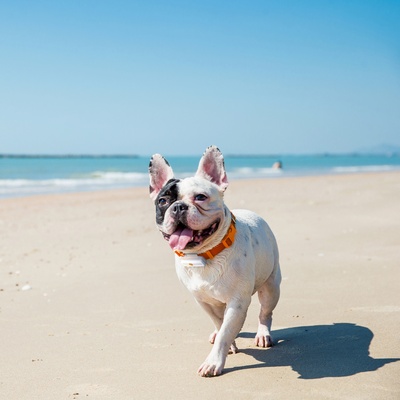
This survey aims to analyse the situations in which pets go missing, particularly during holidays. Its goal is to identify the most common risk factors and to debunk persistent myths surrounding pet loss.
The data was collected from over 700 participants, including Weenect customers (France, Belgium, Netherlands, Germany, Italy, Spain, and the United Kingdom) and respondents from a Meta campaign. The sample includes dog and cat owners living in urban, rural, and peri-urban areas, with varied travel habits and levels of pet supervision.
Discover the detailed results of our study, through a series of graphically illustrated lessons.
In 55.3% of cases, the pet got lost while accompanying its owner on holiday. By comparison, only 7.6% of losses occurred while staying with friends or family, and 0.5% in boarding facilities. This challenges the belief that pets mainly go missing when left with others.
Only 31% of owners always keep their pet restrained (lead, harness, carrier). The others relax their vigilance: 36% only lead their pet in specific areas, 25% let them roam free but supervised, and nearly 6% allow full freedom without constant monitoring. This relaxation, common during holidays, helps explain why so many pets go missing while still accompanied by their owners.
The survey shows that 47.2% of losses happen in natural settings (forest, mountains, countryside), while 52.8% occur in inhabited areas: at home (18.8%), at someone else’s place (9.6%), in holiday accommodations (8.1%), or on public roads (9.6%). Contrary to popular belief, nature is not the only risky environment—daily life poses just as many risks.
Whether the pet is on a forest walk or in the backyard, loss can happen unexpectedly: an open door, a moment of distraction, or a chasing instinct. This even distribution shows that prevention should not depend on the setting, but become a consistent habit, both at home and on holiday.
35.5% of pet losses happen in the afternoon, followed by morning (27.4%) and evening (21.8%). Fewer than 3% happen at night. These numbers show that most losses occur during the day, often during outdoor activities like walks, roadside breaks, or playtime.
43.6% of pet losses occur during the summer holidays, far more than during other holiday periods (spring, winter, etc.) or non-holiday times (23.9%). This is due to a mix of factors: frequent travel, favourable weather for outings, and relaxed supervision.
52% of respondents say their pet behaves differently when arriving in a new place: 27.5% become more curious, while 24.4% are more agitated or stressed. Only 34% remain as calm as they are at home. This change in routine can increase the risk of running away, even in normally stable pets.
While 67.2% of pets are found within 24 hours, 20.4% are recovered after several days, and nearly 12% after weeks—or longer. These timeframes show that a runaway triggered by unusual behaviour can lead to prolonged disappearances, with real consequences for owners.
Among people who lost their pet, 74.4% purchased a GPS tracker afterwards, and 13.5% considered doing so. This response shows that one incident is often enough to change habits and adopt prevention as a protective reflex.
Over 90% of users say they feel more at ease since equipping their pet with a GPS tracker. This feedback shows that adopting this type of device transforms how people experience pet loss—it reduces long-term anxiety for owners.
This study shows that pet loss often occurs in familiar situations: during holidays, walks, or even at home. These settings, perceived as safe, are in fact the most exposed when vigilance is not adapted.
By identifying high-risk moments and behaviours that lead to them, the survey helps shift prevention towards what really matters: supervising pets, preparing for travel, and anticipating their reaction to unfamiliar environments.
To avoid the worst, Weenect GPS trackers offer a simple, reassuring solution: track your pet in real time and find them quickly in the event of a runaway.
To access the most relevant information, suitable payment methods, and delivery in your region, please select the website corresponding to your country.






